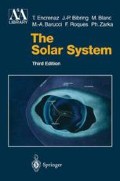Abstract
After the invention of the telescope in the 17th century, it was discovered that the Earth was not the only planet to have a satellite. In 1610, Galileo observed the largest satellites of Jupiter and Huygens discovered Titan, the largest of Saturn’s satellites in 1655. Gradually the number of satellites in the realm of the outer planets grew to about a dozen. Not until the 19th century, however, were the Martian satellites, Phobos and Deimos, observed for the first time. It is only very recently, with the Pioneer and Voyager deepspace missions, that numerous new satellites have been discovered, and their main physical properties have been determined. What is striking is that this family of bodies orbiting the outer planets should show such an extraordinary diversity in their surface conditions, degree of internal activity, internal structure and evolution. Nevertheless it has been possible to establish some general laws regarding orbital parameters and macroscopic properties. For example, almost all the satellites have synchronous rotation, with equal periods of orbital revolution and sidereal rotation: they present the same face to the planet throughout their orbits. This imnlies that tidal forces have stabilized the rotation in an equilibrium state.
Access this chapter
Tax calculation will be finalised at checkout
Purchases are for personal use only
Preview
Unable to display preview. Download preview PDF.
References
Burns, J.A. (ed.): Planetary satellites (University of Arizona Press, Tucson, 1977)
Burns, J.A., Matthews, M.S. (eds.): Satellites (University of Arizona Press, Tucson, 1984)
Greenberg, R., Brahic, A. (eds.): Planetary rings (University of Arizona Press, Tucson, 1984)
Morrisson, D. (ed.): Satellites of Jupiter (University of Arizona Press, Tucson, 1981)
Stern, S.A., Tholen, D.J. (eds.): Pluto and Charon (University of Arizona Press, Tucson, 1997)
Author information
Authors and Affiliations
Rights and permissions
Copyright information
© 2004 Springer-Verlag Berlin Heidelberg
About this chapter
Cite this chapter
Encrenaz, T., Bibring, JP., Blanc, M., Barucci, MA., Roques, F., Zarka, P. (2004). Bodies Without Atmospheres in the Outer Solar System. In: The Solar System. Astronomy and Astrophysics Library. Springer, Berlin, Heidelberg. https://doi.org/10.1007/978-3-662-10403-3_10
Download citation
DOI: https://doi.org/10.1007/978-3-662-10403-3_10
Publisher Name: Springer, Berlin, Heidelberg
Print ISBN: 978-3-642-05530-0
Online ISBN: 978-3-662-10403-3
eBook Packages: Springer Book Archive

